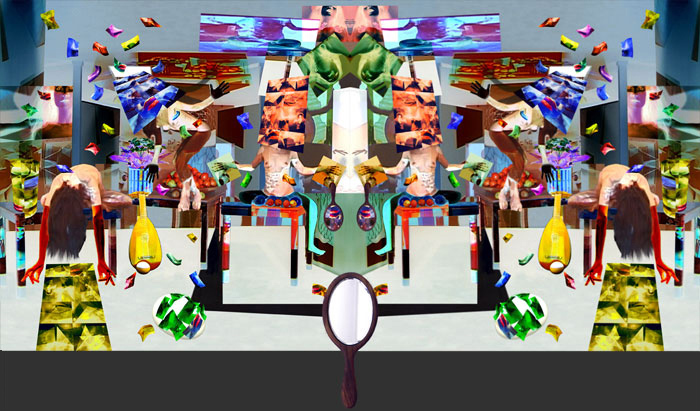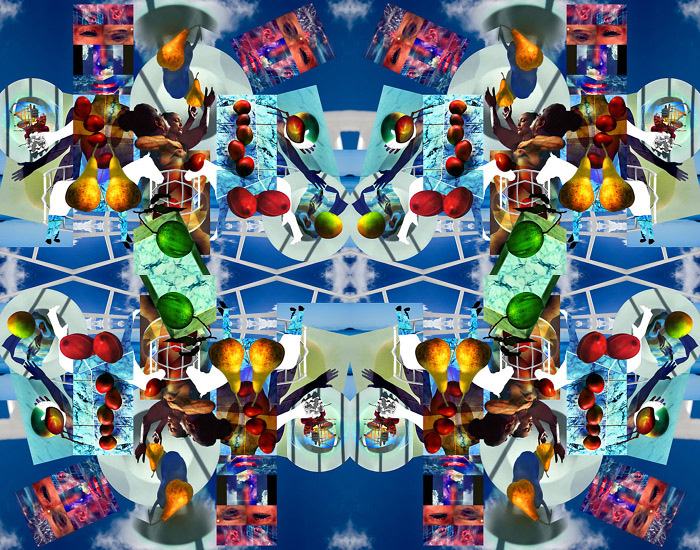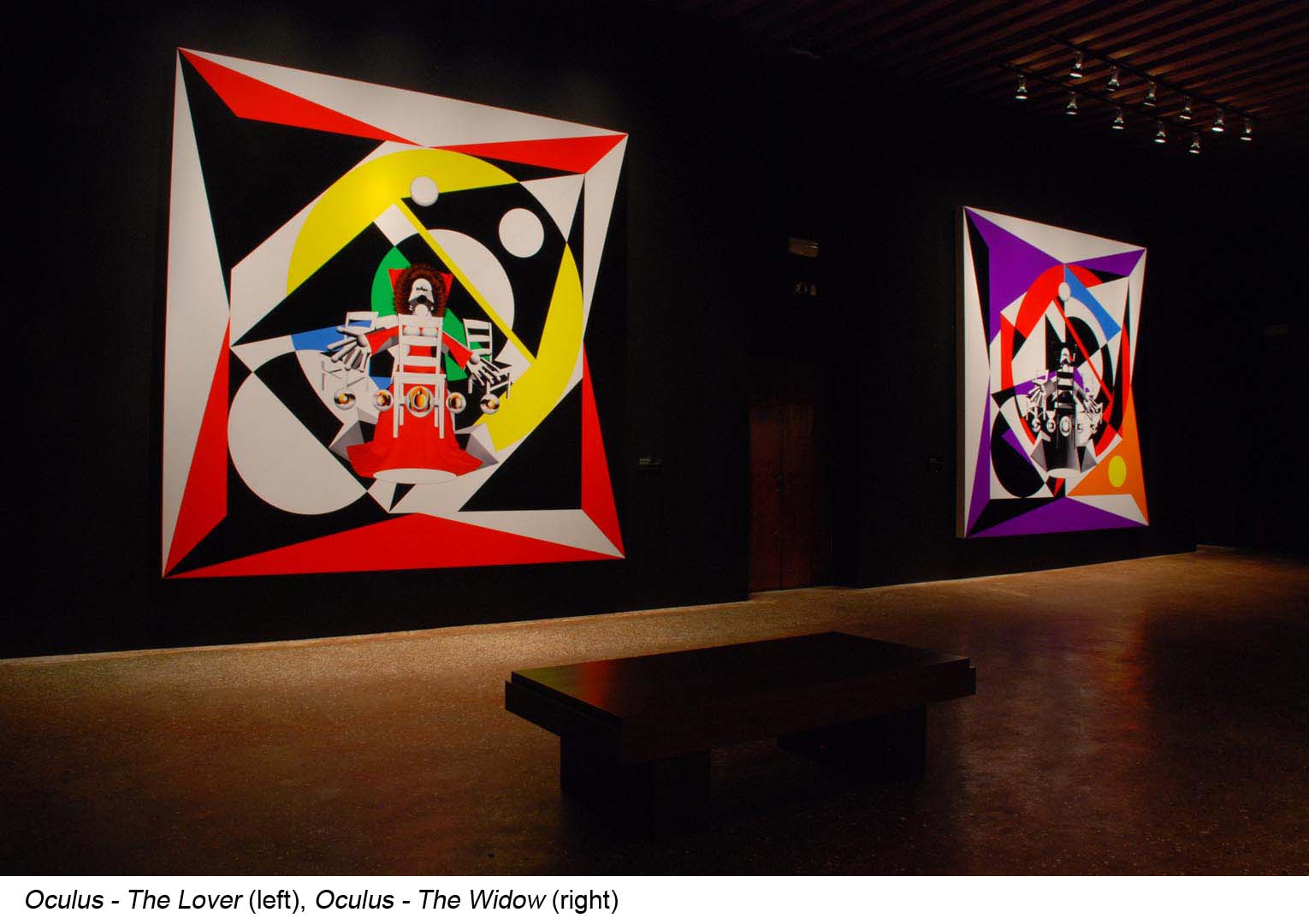|
Geometry and "Point of View"
by Adi Da Samraj
|
Cézanne once stated something to the effect that the
making of the structure of an image can be understood in
terms of cylinders, cones, and spheres. All those are
curved, three-dimensional forms. So Cézanne thought in
three-dimensional and curvilinear terms.
|
 |
| |
Adi Da Samraj |
|
While
this statement is not entirely representative of how Cézanne made
images, much has been made of that statement by modernists, who
have often made images based on geometric concepts of some kind or
another. But it is a plastic concept, a continuation of the
academic tradition, even of the traditional understanding of how
to build up a picture. It is not an understanding of reality
itself.
Cézanne only made this remark one time, and he did not
mean he was literally making images that are made of
cylinders, cones, and spheres. It was just a reference he
made in a letter to somebody about how to build up a basic
structural form tacitly—not actually making a picture of
cones, spheres, and cylinders—and then fill it in. It was
not anything like that, but (rather) merely a general
sense of structure. That was part of the academic
tradition.
My
own artistic work with squares, circles, and triangles—or linear,
curvilinear, and angular—is another matter. My artistic work is
about the structure of conditionally manifested reality, the
structure of perception, the structure of brain-controlled
awareness or perception. My artistic work also relates to the
fundamental structure of conditionally manifested reality in the
human scale—gross, subtle, and causal—with the linear (or square)
being associated with the gross, the curvilinear (or circle) with
the subtle, and the angular (or triangle) with the causal. It is a
different understanding altogether, although it does recall
something of the remark Cézanne made, which modernists have made
much of.
When
I was a boy, I used to watch Jon Gnagy, who was an art teacher on
television at the time, and I got this kit that you could order.
Jon Gnagy would draw an image—for example, a house in the woods by
a stream—and make it out of fundamental shapes, then shade or
round them, and so forth. In other words, he was building up a
picture using geometry. He was continuing this tradition, this
notion—something of the modernist tradition altogether. Thus, I
was getting artistic training in the tradition of modernism, and
in the mode of Cézanne particularly—without the names being
mentioned, without saying anything about modernism. It was just
art-school picture-making—while, in fact, this approach was based
on the modernist tradition and Cézanne’s remark, although Cézanne
himself did not actually make paintings using these forms. He was
just talking about a way of understanding (from an academic
perspective) something about how to generate a sense of how you
build up a picture or an image.
Unlike the impressionists, Cézanne was not interested in merely
responding to what colors were coming to the eye. He was
interested in thinking structure and making structure—of color,
rather than of lines—seeing the surface not as a flat continuity,
but still based on the three-dimensional “point of view”. There
are many different “points of view” reflected in Cézanne’s images.
Each day, he would change his position—standing over here, looking
at a bowl from above, or straight on, or whatever. He painted it
as it looked that day, because that was his perception. He wanted
to see what he was seeing. Working from different “points of view”
was not so much because he had a modernist understanding of the
attempt to transcend perspective. Cézanne was a realist. It is
just that he moved around. Sometimes his fruits would get
overripe, so he would be working on painting a pot, after the
fruit in it had rotted, and be doing the pot from a different
place. He had to really be seeing it as it was in front of him at
the moment. That was the reason why he changed his “point of
view”, while a modernist would work intentionally on changing the
“point of view” of different aspects of the image.
My
own artistic work is about transcending the position of egoity (or
“point of view”) altogether. While something of the dialogue of
modernism in Cézanne is associated with the image-work I do, those
who are considering this seriously should see and understand the
profundity of the difference, also. They should understand the
particularity of this summation of what I am doing. What I am
saying is this: It is not “point of view”, not “point” in space
and time, but reality itself that is the basis for the images I am
making, the entire process of image-making that I am developing.
It is not “point of view”—as if, for instance, to make a circle,
you would point a compass point down and then rotate the pencil or
the inscribing material to make a circle from that point, or that
you would have to measure the circumference around a point by
multiples of pi, which is an irrational number. If the natural
world was based on measuring circles using pi as the measure, the
natural world would never have happened! It would not be happening
now, because pi is not a precisely determinable number.

Adi
Da Samraj - Spectra One
In
that case, how is everything happening? Conditionally manifested
reality is self-organized spherically—not from the “point” that
views it, but from the totality of the happening. That is the
“position” of the imagery that I am making. That is the “position”
of the process of making imagery in which I am involved.
Therefore, I call it “non-subjective” image-art. It is not
“point-of-view” art. It is not merely multiple-“point-of-view”
art—whatever the appearance may be, or whatever it may suggest
relative to ordinary perception. There is some suggestion of that
kind, of course—but it is egoless, not “point-of-view” art.
However, in the image-art I make, I do comment on “point of view”.
I reflect it, and demonstrate the force of reality relative to
what is otherwise “point-of-view” perception. There are many
elements of meaning and many visual characteristics in the images
I make, but it is not based on generating circles or spheres from
“point of view”. It is based on how reality is self-organized
spherically—prior to “point of view”, prior to a center or a
“point” from which to view it or generate it.
The
illusion of egoity is that, somehow, the world is being generated
from your own position, or being shown to your position. That
suggests the idea that the human being must make the measure of
reality and control it—whereas reality is actually self-generated,
beyond “point of view”, beyond control, prior to “point of view”,
prior to control, prior to separateness. You could say the work I
am doing is “Reality-Art”, or (as I call it) “Transcendental
Realism”—not the realism of conventional perception, such as
Cézanne, for instance, was considering.
The
art I make is not about building up pictures based on geometries
manipulated from a “point of view”. Rather, it is about the force
of reality itself, and generating images based on that
force—which, most fundamentally, is a spherical force. It is a
force of prior unity (or all-inclusiveness). Thus, when I make
images on a flat plane, the fundamental impulse is not to imitate
three-dimensionality. It is about a flat rendering (or
demonstrating) of the nature of the force of reality itself—prior
to “point of view”, prior to egoity. I am not just involved in an
aesthetic or a program for how to make a picture from shapes and
so on. I am not sitting in “point of view”.
Therefore, through artistic means (as I also do through verbal
means), I am working to demonstrate the nature of reality
itself—just as it is, as it is self-evident to me already. I am
not merely trying to make paradoxical images, but rather to
demonstrate how the world is in reality itself, and how awareness
of the world as it is in reality itself can show itself even to
humanity in general, human beings who are otherwise seeing things
from “point of view”, and who are also habituated to looking at
pictures that are built upon conventions historically agreed upon,
such as the Renaissance idea of perspective. The imitating of the
real world through the use of rules of perspective started in the
fifteenth century, and then that became the academic convention of
how to make pictures.

Adi
Da Samraj - Spectra Three
One
of the aspects of modernism that changed that was the
relinquishment of the idea of perspective—as in Cézanne’s case, or
the work of cubists such as Picasso and Braque, who began making
pictures based on multiple “points of view”. But, even so, that is
still taking the position of “point of view”, to make a picture
that is paradoxically associated with the “point of view”. That is
not what I am doing.
This
is, in part, why I am tending toward the flat two-dimensional
approach now. I am not trying to imitate three-dimensional
reality. In Cézanne’s statement, he is still talking about
three-dimensional forms—cylinders, cones, and spheres. He is not
talking about circles, triangles, and squares—not flat geometries.
Rather, he is still conceiving things conceptually and
understanding them in terms of volume—still seeing forms in the
plane of conventional realism, in the mode of traditional
picture-making based on “point of view” and perspective.
I am
not really involved in picture-making. The position in which I am
making images is not simply picture-making in and of itself.
Rather, the basis on which I am making pictures at all is the same
in which I speak and live and work altogether. It is already prior
to “point of view”, already without “point of view”.
“Point-of-view” perception is part of the convention of day-to-day
awareness. On the other hand, neither am I simply trying to make
pictures that are paradoxical over against “point of view”—rather,
I make images that are prior to “point of view”.
Therefore, the images I make are not merely images based on
multiple “points of view” and the deconstruction of perspective.
Rather, they are generated prior to “point of view”, prior to
conventions of picture-making based on the tradition of
perspective and rules in the academic tradition. I go beyond all
those conventions.
Just
as using the camera (which is a “point-of-view” machine)
inevitably makes images on a certain basis, I have had to work
with the camera now for years to overcome “point of view”. Of
course, I used multiple exposure as a means to do that. And that
was something I was particularly doing when I was using film
cameras. Now that I am using digital cameras, I am not trying to
make multiples—although I could.
In
fact, at the moment, I am not using photography at all, as I was
before. When I shoot images, I shoot single-frame forms. I have
not been including them in the images lately (although I expect to
do so again)—but, day to day, I respond to them. They are sort of
like a sketchpad. I bring them to the studio, work further by
responding to them, and generate images in response to them,
rather than actually putting the photographs into the image. I
expect to use the photographs within the images in various ways,
but still as a means of going beyond this “point-of-view” machine.
The
body is a “point-of-view” machine. It is an ego-machine. I do not
want to simply use it as such, as a convention of communication or
perception, but (rather) to go beyond that. The body can be a
means for generating images for others, who are also bodily
existing, to see—and, optimally, for those seeing the images to go
beyond just looking at them and to actually participate in them.
I am
manifesting the self-organizing force of reality in the context of
perception and communication—and, therefore, of images.
Cézanne and the impressionists characteristically used little,
short brushstrokes. My so-called “brushstrokes” are very, very
small. They are bytes, pixels—more directed to how the brain
organizes and generates visual perception. My interest in the
digital process, however, is not merely technical. In fact, I do
not really want much to do with that. I want to simply make use of
the visual characteristics (as with the camera) that are possible
using the digital means without getting involved in the machinery
of it, the procedures of it, the linearity of it, and all the rest
of the mind of it. I just work on it strictly as a visual process,
without having to become embedded in the “technology-position”. I
prefer to keep apart from that, just as I do not want to get
over-immersed in the technology of the camera or anything else
like that. I am always going beyond it, always standing prior to
it, standing free of being subordinated by it.
So
when I work, I am always standing outside the “seat” of the
technology. The interest is strictly in terms of visual or
perceptual phenomena, so that I am still working with the
fundamentals of image-process, or the fundamentals of perception,
rather than getting involved in “techie” business (either with
camera or with digital means). In that case, I can be fully
involved in the perceptual process and in the generating of images
that manifest the characteristic of reality itself.

Copyright © 2007 ASA. All rights reserved. Perpetual copyright
claimed.
|





